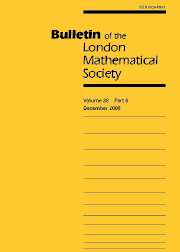Crossref Citations
This article has been cited by the following publications. This list is generated based on data provided by
Crossref.
Bernal-González, L.
2005.
Hypercyclic subspaces in Fréchet spaces.
Proceedings of the American Mathematical Society,
Vol. 134,
Issue. 7,
p.
1955.
Petersson, Henrik
2006.
Hypercyclic subspaces for Fréchet space operators.
Journal of Mathematical Analysis and Applications,
Vol. 319,
Issue. 2,
p.
764.
Bernal-gonzález, L.
Calderón-Moreno, M. C.
and
Prado-Bassas, J. A.
2007.
Cyclicity of coefficient multipliers: Linear structure.
Acta Mathematica Hungarica,
Vol. 114,
Issue. 4,
p.
287.
Costakis, George
and
Hadjiloucas, Demetris
2007.
Topologically transitive skew-products of backward shift operators and hypercyclicity.
Proceedings of the American Mathematical Society,
Vol. 136,
Issue. 3,
p.
937.
Fernández Valles, A.
2008.
Common non-trivial invariant closed cones for commuting contractions.
Linear Algebra and its Applications,
Vol. 428,
Issue. 11-12,
p.
2955.
Bermudo, Sergio
Montes-Rodríguez, Alfonso
and
Shkarin, Stanislav
2008.
Orbits of operators commuting with the Volterra operator.
Journal de Mathématiques Pures et Appliquées,
Vol. 89,
Issue. 2,
p.
145.
Valles, Aurora
2008.
Common non supercyclic vectors for commuting contractions.
Studia Scientiarum Mathematicarum Hungarica,
Vol. 45,
Issue. 4,
p.
511.
León-Saavedra, F.
and
Piqueras-Lerena, A.
2008.
On weak positive supercyclicity.
Israel Journal of Mathematics,
Vol. 167,
Issue. 1,
p.
303.
León–Saavedra, F.
Piqueras–Lerena, A.
and
Seoane–Sepúlveda, J. B.
2009.
Orbits of Cesàro type operators.
Mathematische Nachrichten,
Vol. 282,
Issue. 5,
p.
764.
del Pilar Romero de la Rosa, María
2009.
Regular orbits and positive directions.
Positivity,
Vol. 13,
Issue. 4,
p.
631.
BAYART, FRÉDÉRIC
COSTAKIS, GEORGE
and
HADJILOUCAS, DEMETRIS
2010.
Topologically transitive skew-products of operators.
Ergodic Theory and Dynamical Systems,
Vol. 30,
Issue. 1,
p.
33.
FAGHIH-AHMADI, M.
2012.
ON SUPERCYCLIC OPERATORS WITH ADJOINTS HAVING NONEMPTY POINT SPECTRUM.
International Journal of Mathematics,
Vol. 23,
Issue. 11,
p.
1250112.
Costakis, G.
and
Vlachou, V.
2012.
Interpolation by universal, hypercyclic functions.
Journal of Approximation Theory,
Vol. 164,
Issue. 5,
p.
625.
Salas, Héctor N.
2013.
The Strong Disjoint Blow-Up/Collapse Property.
Journal of Function Spaces and Applications,
Vol. 2013,
Issue. ,
p.
1.
2015.
Lineability.
p.
229.
Azimi, M. R.
2018.
J-Class Sequences of Linear Operators.
Complex Analysis and Operator Theory,
Vol. 12,
Issue. 1,
p.
293.

